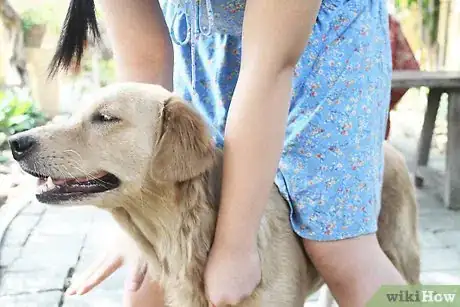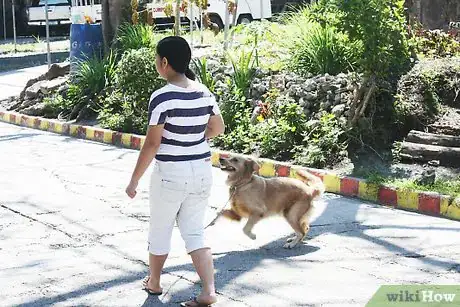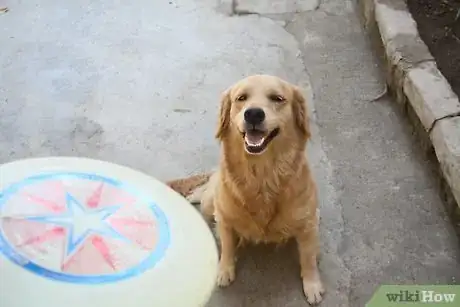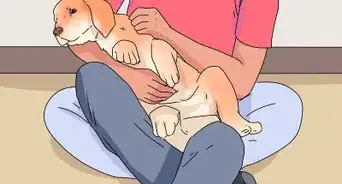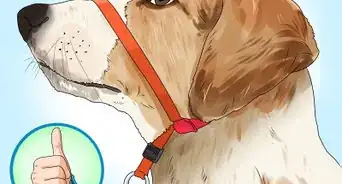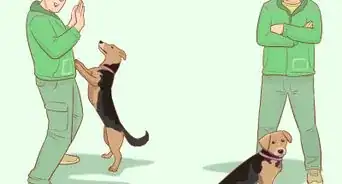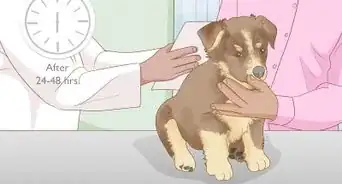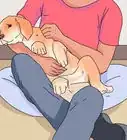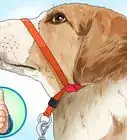This article was co-authored by Elisabeth Weiss. Elisabeth Weiss is a Professional Dog Trainer and owner of Dog Relations NYC, a dog training service in New York, New York. Elisabeth relies on science-based, force-free, and reward-based techniques. Elisabeth offers behavior training, puppy manners, body awareness and injury prevention, diet, exercise and dog nutrition services. Her work has been featured in New York Magazine and on the Dog Save the People podcast. She also trained all the dogs in the movie "Heart of a Dog" by Laurie Anderson that features Elisabeth's journey with Laurie Anderson's and Lou Reed's dog Lolabelle and how her passion for playing the keyboards played a significant role in improving her quality of life after being diagnosed with pancreatic cancer.
This article has been viewed 454,299 times.
Dogs are social creatures that are used to living in family groups when in the wild. If you notice your dog behaving badly, it may be because he needs the guidance of a leader who is like a senior parent to him. By establishing yourself as a leader, you can control his behavior and create a stable, comfortable environment for your dog. This can relieve his stress and anxiety. Avoid punishment or older theories involving dominance as this are likely to make your dog fearful or competitive. As leader, you teach your dog to make good decisions and will receive respect and loyalty in return.
Steps
Creating a Leader Mentality
-
1Determine if your dog is poorly behaved. If you've noticed your dog showing common behavioral issues, like pulling on his leash during walks, having bad manners around other dogs and people, or barking and whining, your dog might not understand the rules of how he should behave. Without an established leader, your dog will misbehave, which can cause the behavioral problems.[1]
- If you take on the role of leader, you can reduce your dog's anxiety and nervousness. Your dog will also be less likely to act out, potentially harming you or others. Fortunately, you can make changes to the social structure of your household no matter how old or young your dog is.[2]
-
2Think like a dog. To better communicate, realize that your dog tends to live in the present much more than you do. This means your dog is much more comfortable with learning new things or new situations, regardless of any trouble he may have had with them in the past. If you start to think in the present too, you'll understand your dog better.[3]
- Since dogs don't communicate the same way as humans do, learn to read your dog’s dog body language so you can understand your dog’s state of mind.
Advertisement -
3Create boundaries. Your dog should look to you for guidance in certain situations. If your dog usually decides when to use these areas, then the boundaries are not clear within your family.[4] You should also set boundaries by only responding to calm behavior. For example, teach your dog that he will only get his food if he's relaxed, not jumping up on you begging to be fed.
- Be firm with the boundaries you set. For example, if you never allow your dog to play in a certain room, offer him alternative spaces to play and make sure he never plays in an off-limits area. Bending the rules will only confuse your dog.
-
4Have fun and play with your dog. Don't forget that playtime is important for your dog's mental stability and your relationship with your dog. Part of your job as leader is guiding your dog through life by being a confident, loving, tough, and fair leader.
-
5Remain calm. In the wild, leaders enforce rules and boundaries with a calm and assertive energy. Leaders don't bully or use violence to show their authority, and neither should you. While it's easy to become frustrated with your dog if he continually breaks rules, never lose your patience.[5]
- Remember, your dog can sense changes in your attitude and energy better than other humans can. This makes it especially important to stay calm during emotional situations.
Acting Like a Leader
-
1Show your dog that you're in control. One way to prove yourself as leader is to always walk through doorways or gates ahead of your dog when entering or leaving your home. This shows your dog your dog that you're in charge and he can be confident with you as his leader. This will also teach your dog good manners.
- This trust and confidence in you helps reduce the likelihood that there will be any separation anxiety in situations where you leave your home without your dog.[6]
-
2Set rules for walking your dog. Set the rules for an enjoyable walk with your dog on his leash. Don't allow your dog to walk in front of your or pull and tug on the leash. Instead, have your dog walk beside or behind you. To do this, you should walk your dog with a standard, 6-foot, non-retractable leash. Hold the leash so that there's only enough room for your dog to stay by your side without being able to move in front of you.
- You should always be the frontrunner in any walk. This will signal to your dog that you're in control.[7]
-
3Train your dog in basic commands. You're responsible for raising a good canine citizen. Teach your dog basic commands including, "sit," "stay," "come," and "lie down." Your dog should eventually learn to respond quickly and correctly to your commands. To encourage your dog, use positive reinforcement techniques, by rewarding your dog with treats, affection and positive words, such as "good dog." Commands show your dog that you're in charge, help you keep your dog's behavior in line, and teach your dog how to be a well-rounded member of your family.
- You can start training puppies at 1 to 2 months old and even old dogs can learn new tricks.
- If positive training techniques don't work, try another training method that doesn't involve strong discipline during training.[8]
-
4Keep your dog active. It's your job as leader to make sure your dog stays active and healthy, allowing him to thrive. Take your dog one or two 20 to 30 minute walks a day. This can keep your dog mentally and physically healthy.[9]
- If your dog is inactive, he can become restless and bored. This can lead to unwanted behavior, like chewing, or barking.
-
5Be consistent. As a leader, you need to be consistent and clear with your rules. Occasionally bending rules only confuses your dog and sends the message that you're not a reliable leader. Your goal is to always remain strong and fair in your dog's eyes and show him that you are the best choice for a trustworthy leader. Repetition and consistency are best ways your dog will learn.[10]
- For example, if you reprimand your dog for begging at the dinner table today and then feed him scraps from the same dinner table tomorrow, you are not being clear and consistent with your rules. This can plant a seed of doubt in your dog's mind that you may not be a very strong leader.
-
6Respond to misbehavior. Calmly and in a firm voice, give your dog a basic command. Your goal is to reassert your authority and remove him from the bad behavior.[11]
- For example, if your dog jumps up on other people, calmly and firmly tell him to "sit." If he still misbehaves, remove him from the area, withdrawing your attention.
Expert Q&A
-
QuestionMy dog has a hard time concentrating during training sessions, even when I use her favorite food. What should I do?
 Pippa Elliott, MRCVSDr. Elliott, BVMS, MRCVS is a veterinarian with over 30 years of experience in veterinary surgery and companion animal practice. She graduated from the University of Glasgow in 1987 with a degree in veterinary medicine and surgery. She has worked at the same animal clinic in her hometown for over 20 years.
Pippa Elliott, MRCVSDr. Elliott, BVMS, MRCVS is a veterinarian with over 30 years of experience in veterinary surgery and companion animal practice. She graduated from the University of Glasgow in 1987 with a degree in veterinary medicine and surgery. She has worked at the same animal clinic in her hometown for over 20 years.
Veterinarian Keep her training treats in a bag around your waist. In the house, whenever you remember you have a dog, do a quick training session, such as asking her to sit and then to lie down. Reward her. Training little and often teaches her to pay attention to you. Train in an environment where there are few distractions, such as at home or in the yard. As she learns to focus, take the training out on walks. Also, teach her the "Look" command as a way of holding her attention on walks when she may be distracted by people, dogs, or bicycles.
Keep her training treats in a bag around your waist. In the house, whenever you remember you have a dog, do a quick training session, such as asking her to sit and then to lie down. Reward her. Training little and often teaches her to pay attention to you. Train in an environment where there are few distractions, such as at home or in the yard. As she learns to focus, take the training out on walks. Also, teach her the "Look" command as a way of holding her attention on walks when she may be distracted by people, dogs, or bicycles. -
QuestionHow do I stop my dog from attacking my other dog?
 Pippa Elliott, MRCVSDr. Elliott, BVMS, MRCVS is a veterinarian with over 30 years of experience in veterinary surgery and companion animal practice. She graduated from the University of Glasgow in 1987 with a degree in veterinary medicine and surgery. She has worked at the same animal clinic in her hometown for over 20 years.
Pippa Elliott, MRCVSDr. Elliott, BVMS, MRCVS is a veterinarian with over 30 years of experience in veterinary surgery and companion animal practice. She graduated from the University of Glasgow in 1987 with a degree in veterinary medicine and surgery. She has worked at the same animal clinic in her hometown for over 20 years.
Veterinarian You need to work out what is motivating the attacks. This might require the intervention of a qualified animal behaviorist. A common source of tension is that the attacker wants to dominate a subordinate dog, but the owner may accidentally bolster the subordinated dog's position. The latter happens when you feed the underdog first or put his leash on first. Instead, carefully consider who is top dog and then give them first attention under all circumstances.
You need to work out what is motivating the attacks. This might require the intervention of a qualified animal behaviorist. A common source of tension is that the attacker wants to dominate a subordinate dog, but the owner may accidentally bolster the subordinated dog's position. The latter happens when you feed the underdog first or put his leash on first. Instead, carefully consider who is top dog and then give them first attention under all circumstances.
References
- ↑ http://www.dogfoodinsider.com/become-a-pack-leader/
- ↑ http://www.dogfoodinsider.com/become-a-pack-leader/
- ↑ http://moderndogmagazine.com/articles/think-your-dog/17433
- ↑ http://www.dogtrainingbasics.com/becoming-pack-leader/
- ↑ http://www.cesarsway.com/dog-psychology/pack-leader/how-to-be-a-pack-leader
- ↑ http://www.cesarsway.com/dog-psychology/pack-leader/establishing-leadership-with-your-new-addition
- ↑ http://www.cesarsway.com/dog-psychology/pack-leader/establishing-leadership-with-your-new-addition
- ↑ http://www.dogfoodinsider.com/become-a-pack-leader/
- ↑ http://www.dogfoodinsider.com/become-a-pack-leader/
- ↑ http://www.dogfoodinsider.com/become-a-pack-leader/
- ↑ https://books.google.com/books?id=PyfmFs0Bm1YC&pg=PA63&lpg=PA63&dq=how+to+respond+as+dog+pack+leader+to+misbehavior&source=bl&ots=hd-akeq7y8&sig=0sD42ho9XxcAu6GlVAHshpO7S8k&hl=en&sa=X&ved=0CD4Q6AEwBWoVChMIxfGy3bjrxwIVCCyICh05pQ_T#v=onepage&q=how%20to%20respond%20as%20dog%20pack%20leader%20to%20misbehavior&f=false
About This Article
To control your dog’s behavior by becoming a pack leader, start by creating boundaries, like only feeding it once it’s calm or not allowing it on furniture. Then, stay consistent with your boundaries, since bending the rules will confuse your dog. Additionally, walk through doors or gates ahead of your dog to show it that you’re in charge and confident in your authority. When you’re with your dog, remain calm and assertive, because losing your patience will cause it to lose trust in you. For tips from our Veterinary co-author on how to respond to your dog’s bad behaviors, read on!



